|
News 2007
November
- December 2007:
|
In
the beginning of December we enjoyed the first serious rains in
Thuma F.R. and Dedza-Salima F.R. Dark skies contrast sharply with
the exploding bright colors of the reviving vegetation. In the
coming weeks the rain will turn the dry stream beds again into the
familiar flowing silver lines which meander around the hills and
mountains through the reserves and the animals will disperse, no
longer being confined to the few places where water was still to
be found. The months of plenty have arrived again, giving all
wildlife the annual kick start for the new year.
And
looking back, 2007 was again a successful year. Despite the normal
unavoidable smaller setbacks and 'struggles' here and there, we
have managed, with the support of many, to take a series of
important steps forward: many of them mentioned in the paragraphs
below. |
|
 |
|
We would therefore like to take this opportunity to thank
everybody for the interest you have shown this year for our work
and we hope that you will keep on supporting our and all other
conservation efforts in Malawi. Two words: Zikomo
kwambiri ("Thank you very much")!
|
October 2007:
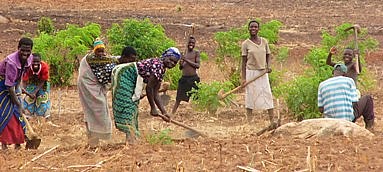 |
With
the final approval from the Department of Forestry to start our new
conservation project in Dedza-Salima Forest Reserve (see Dedza-Salima
Project), we have started
this month with the constructing of a base camp in the reserve. As much
work as possible, which includes the collection of building materials and
road construction (see picture) is handed out to the villagers in the
area, thereby generating an important direct inflow of conservation
related income towards the local communities. With the massive response
from the communities on our request for labour, we most likely will be
able to finish most of the work before the first rains and at the same
time it will enable the villagers to purchase the so much required fertilizer
with the money they earn. |
September
2007:
| The
Mammal Survey 2007 (see June news) is going with full speed. Both scouts
and volunteers are doing an excellent job, despite daytime temperatures of
up to 35░C in the shadow (the vervet monkeys, however, take a more
relaxing approach these days: see picture) We expect to finish the survey
in November but, so far, the preliminary findings look very interesting
and promising. Later more.
An interesting new website (www.safaritalk.net),
covering conservation projects and issues in Africa, has put a feature about W.A.G.'s work on their website.
Check it out! |
|
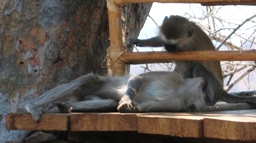 |
July - August
2007:
|
These
months we received excellent news from the funding side: the United States
Fish and Wildlife Service (www.fws.gov)
who has been funding our conservation work in Thuma F.R. in the last 12
months, has approved our request for another year of funding. In one word:
fantastic! This means that we can continue to maintain the high level of
protection we have been able to achieve in the last year. And the results
of this are showing.
An example is the number of snares we have found and removed in the last
years (see graph).
As can be seen
on the graph, the number of snares put out throughout
the year (and therefore found and removed by us) follows a certain pattern with
a distinctive peak in the months April - August.
|
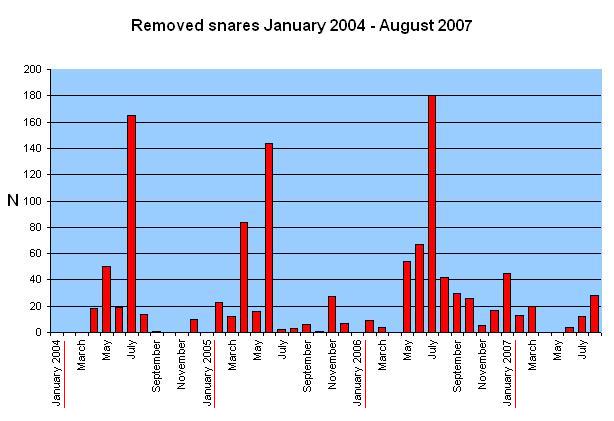 |
Taking a
closer look at the period January - August (to make it possible to include the
2007 data in this comparison) the numbers of removed snares for each year are: January
- August 2004: 266
January - August 2005: 284
January - August 2006: 356
January - August 2007: 122
It is obvious
that with the increased number of employed scouts in 2006 more
snares were collected in 2006 than in the two previous years. That was a good
start.
And by
removing so many snares in 2006, it appears that this year much less people are
interested in putting out snares in Thuma F.R. because they have apparently
experienced last year that the chance of the snares being removed by the scouts
has increased significantly. The result so far is therefore that we only had to
remove 122 snares this year. An excellent development which will undoubtedly
have the positive effect on wildlife numbers we are looking for.
June 2007:
This month we have started with
the Mammal Survey 2007. The volunteers Frodo Wesseling from the Netherlands and
MaitÚ Guignard from Switzerland have joined our team in Thuma F.R. this month
to assist with the survey and several other volunteers will follow in the coming
months. The planning is to survey as many of the 208 square
kilometer blocks of Thuma F.R. as possible and record the signs (meaning
presence) of the different mammal species.
Last year we did the first mammal
survey in Thuma F.R. which produced very interesting data (see Thuma
F.R. Mammal Survey 2006).
By repeating the survey this year, we are hoping, besides recording the presence
of the different mammal species in the different parts of Thuma F.R., also to
record any possible changes in distribution patterns in comparison to last year.
Any change in these patterns might give us a valuable indication of the effects
of our conservation efforts in Thuma F.R..
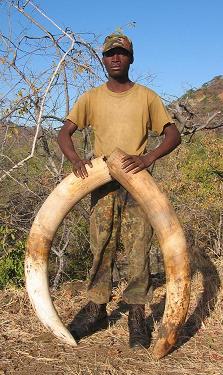 |
Though
poaching levels have dropped significantly in Thuma F.R. in the last
years, total protection of the elephant population in the forest reserves
in this part of Malawi has not been achieved yet. At the end of this
month, scouts Matthews and Edison found the remains of an elephant at a
distance of about twenty minutes walking from our Base Camp. The estimated
40 to 50 year old bull died about 2 to 3 months ago. Investigation
revealed that the bull has very likely been killed by poachers: the molars
of the animal were in good condition, excluding old age as the cause of
death, it had a full stomach, most likely excluding disease as the cause
of death, and the animal was found on the slope of a hill, suggesting that
it more or less literally dropped dead on the spot (on contrast, elephants
which feel their end is coming because of old age or disease, often retreat
to thick bush near water).
However, the tusks were
still on the animal. Besides that, we haven't heard any gunshots in
Thuma F.R. for about a year now and if the animal would have been shot
near the spot where we found it, we would for certain have heard it in
camp. Though speculative, a likely scenario therefore seems that the
animal was shot by poachers in the adjacent Dedza-Salima Forest Reserve
(or along its boundaries), where poaching is rampant, and that the animal
managed to 'escape' to Thuma F.R. where it eventually died.
Apparently, the poachers hadn't dared to track and follow the mortally
wounded bull into Thuma F.R. which explains the presence of the tusks.
All by all an unfortunate
happening. This incident expresses the need and urgency for W.A.G. to
expand its work to Dedza-Salima Forest Reserve as soon as sufficient
funding is available. |
| The
tusks, each weighing 14.5 kg (see picture), were recovered by us and
handed over to the director of the Department of National Parks and
Wildlife who expressed his gratitude, and especially his appreciation for
the honesty of the scouts who had reported the discovery of the dead
animal. |
May 2007:
We would like to ask your attention for a fantastic and tremendous useful
initiative initiated by W.A.G. Support (our membership support organization in
Europe): The
Bushtaxi; a
new car for Thuma F.R.
Despite the
fact that a vehicle is a quite expensive budget 'burden', it is however an
absolutely necessity for our work in Thuma F.R..
The Toyota
Land Cruiser, we are using now, is running on its last legs (tires): it has
endured severe bush conditions for over 10 years now, repairs and maintenance
costs are rising and a sudden breakdown of the car could result in serious
problems or even incidents.
Therefore, the
time has come to start thinking about the replacement of our old car, because
without a car, W.A.G. would for example not be able to:
-
hand
over any arrested poachers to the police in Salima (about 40 km away from
our base camp),
-
assist
communities in sudden cases of crop raiding elephants, especially at night,
-
run
the volunteer programme since none of them could be transferred from/to the
airport, and no supplies, also for W.A.G. staff, could be transported to
W.A.G.'s base camp in Thuma F.R.,
-
the
safety of W.A.G. staff and visitors would be at serious risk since the
nearest (proper) hospital is at a distance of about 2 hours driving (in
Lilongwe),
-
attend
the necessary meetings, update W.A.G.'s website, check (e-)mail etc.
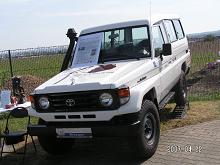 Needless
to say, a vehicle is therefore not so much a luxurious item but a logistic
necessity; without a vehicle the direct consequence would be a rapid collapse of
the operational work of W.A.G. in Thuma F.R.. Needless
to say, a vehicle is therefore not so much a luxurious item but a logistic
necessity; without a vehicle the direct consequence would be a rapid collapse of
the operational work of W.A.G. in Thuma F.R..
Fortunately
W.A.G. Support has picked up this issue. Kristina R÷sel (Chair of W.A.G.
Support), Nicole
Straube and Michael Hesse (2 members of W.A.G. Support) are organising a new car
for Thuma F.R.: a Toyota Land Cruiser (see picture).
The
car has already been purchased and in October this year the car will be
transferred
on its own axis by Michael and one or two more volunteers via Tunisia, Libya,
Sudan, Ethiopia, Kenya, and Tanzania to Malawi; final destination Thuma F.R.!
For
more information about this very important initiative: see the website of
W.A.G. Support Europe.
April 2007:
Problems
with crop-raiding elephants reach(ed) their peak during the past and
coming few weeks. 
Despite the fact that food is most abundant in Thuma F.R. these days,
the lure of ripening maize, pumpkins and groundnuts on the farmers
fields is difficult to resist by elephants: it is easy accessible,
conveniently planted on small areas (gardens) in high density and most
important ... it simply just tastes great! With a boundary bordering
villages and farm fields of about 50 kilometers, W.A.G. staff is not
able to assist farmers all the time everywhere around Thuma F.R. during
these weeks. The same applies for staff from the Department of National
Parks and Wildlife who even have to assist communities around all
forest and wildlife reserves in Malawi where wildlife is helping itself
in these free 'restaurants'.
One
option would be handing out fire crackers to farmers. Good fire crackers
definitely scare off crop raiding elephants (and other crop raiding
wildlife like bushpigs) and are at the same time much cheaper than
sending scouts or game rangers to areas too big to control. At the same
time handing out crackers to farmers would be more efficient since the
crackers are there where they are needed at
the moment they are needed (it is often rather difficult to predict when
and where the elephants go out).
However
reality learns that free hand-outs (of anything) is often not a
sustainable way to solve a problem. Therefore, inspired by Malawi
government's subsidized fertilizer program╣,
we have started this year with providing farmers on the East side of
Thuma F.R. with subsidized fire crackers. Farmers can purchase fire
crackers from W.A.G. for 10 Malawi Kwacha (5 Euro cents) each, the other
60% of the purchase price is paid by W.A.G.. In this way fire crackers
become just a part of the input required for farming, the same like
land, labor, tools, seeds, fertilizer and pesticides, and therefore
every farmer can take the protection of his crops for a large(r) part in
his (or her, of course) own hands.
So
far the subsidized crackers seem to contribute positively to the
reduction of damage caused by crop raiding elephants. In the future, the
idea needs to be studied and developed further and I think it will be
wise to give the farmers first a short training next year in how and
when to use the crackers to avoid the potential risk that the wrong or
unnecessary and excessive use of fire crackers might lead to the
elephants becoming insensitive to loud bangs in and around the gardens.
╣For
the second year in a row, Malawi government has provided farmers with
subsidized fertilizer which is sold to farmers for about one third of
the market price. This,
together with the prolonged periods of rainfall, has resulted in two
bumper harvests of maize in the last two years with an amazing surplus
of 1 million tons of maize this year. |
March 2007:
In the second half
of the month, the heavy rains have come to an end and in the coming weeks the
last light showers will be the last farewell of this rainy season. Despite all
the rains, the scouts have spent well over 200 days in the bush in the last
month. With so many days in the field (not only this month but in the last year)
and with the law enforcement support of the game rangers from the Department of
National Parks and Wildlife, poachers have started to avoid Thuma F.R.. Though
spotting wildlife this time of year is difficult due to the thick bush, the
direct positive effect on the wildlife populations will without doubt become
evident the coming dry season when game spotting opportunities will be better
than ever before: something to look forward to!
And on the last day
of the month, we have held the first conservation awareness day in the village
Chilombo. Drama, poems, songs, a quiz and discussions were on the program.
Especially the drama was of remarkable quality and fun: see the picture below.
For sure a day that will be organized more often in the coming months.
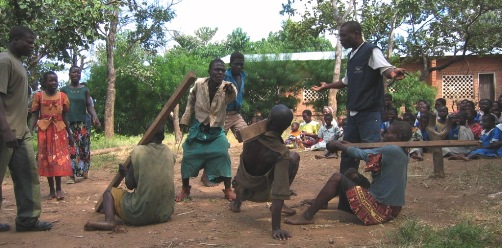
The 'chief' (middle)
making it clear to 3 'poachers' that chopping down trees
without planting new ones, is not tolerated in his village.
February 2007:
Food for thought:
Bushpigs, baboons and
elephants know that there is a lot of nice food to be found in the villages this
time of the year: fields full of maize, groundnuts, cassava and bananas work as
a magnet on wildlife and the villagers are out on fulltime watch to scare off
any intruder from the bush. In the case of persistent crop raiding elephants,
W.A.G. is assisting the people by sending a scout with fire crackers to the
village to chase away the elephants. Generally this works well though this year
we are experiencing a human-wildlife problem of a new category.
Halfway
last month one of the biggest bull elephants of Thuma crossed the Lilongwe River, which forms the Northern boundary of Thuma, in search for a different kind of
food in Chilombo village. During his night out however, heavy rains in the water
catchment area of the Lilongwe River, made the river swell to immense proportions, making it impossible for the bull
to return to Thuma in the following early morning. Soon the people from Chilombo
came to us to complain about the elephant which was causing continues serious
crop damage while being stuck in Chilombo. Immediately we positioned a scout,
assisted by 2 game rangers from the Department of National Parks and Wildlife,
in Chilombo whose duty was to keep the elephant away from the people's crops
(and to keep the people away from the elephant) in order to reduce the chance of
any serious human-elephant conflict.
However,
time was against us: after 3 weeks the bull was still not able to cross the
river because of continuous heavy rainfall and it became clear that the elephant
was not able to find enough food (other then maize or other crops) to sustain
itself for any prolonged period of time.
The day was approaching that it would not be possible anymore to keep the bull,
which was getting more and more hungry, away from the gardens of the people
whose life directly depends on the amount of maize they can grow each year.
This
situation raised an interesting but very unpleasant moral issue: conservation is
about wildlife Ónd people and the overall goal in conservation is to create a
situation where people and wildlife can co-exist and benefit from each other.
But there are situations where you, as a conservationist, might be forced to
make a tough choice. I mean: how much damage is a crop raiding elephant allowed
to cause before it has to be shot ...? Note: Malawi government does not pay
compensation for crop damage caused by wildlife.
Fortunately,
a few rare days with no rain, made the water level in Lilongwe River drop to the
low level which made it possible for the bull to return to Thuma again. All
ended well for the elephant though it was a close call.
Sielke
Steelant from Belgium has come to Thuma to make an inventory of the
butterflies living in Thuma. Her 3 months stay is a part of the final year
of her study Nature Management.
At the same time, Jan Verachtert, who did his internship in Thuma last
year, has returned to Thuma this month, this time as a graduate, and he
will continue his research on the orchid species in Thuma. |
The
butterfly Pretoria Red Lines (Cyana pretoriae). |
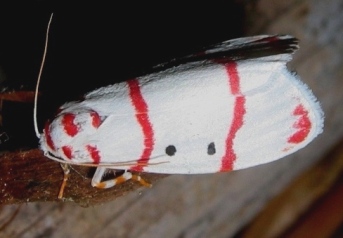
|
January 2007:
Rain, rain, rain and rain...
|





